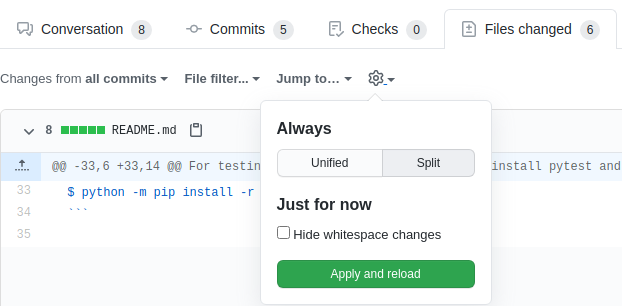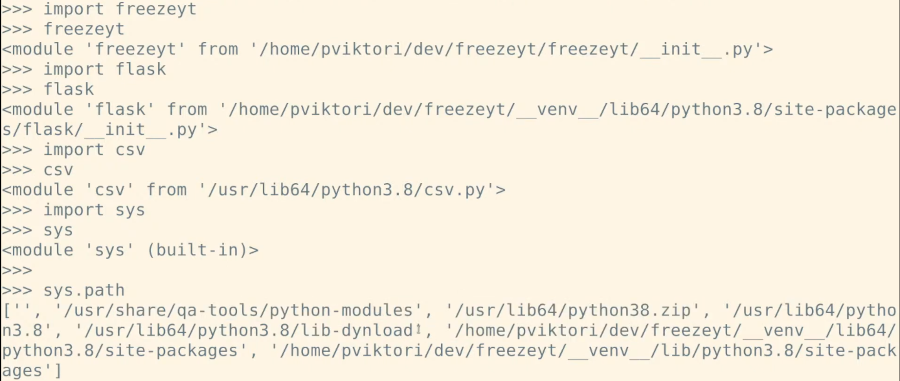Web App Best Practices and Tests Parametrization
10th Online Meeting, September 7, 2020
Mentor: Petr Viktorin
Checking New PRs
TO-DO
- Remove excess images, and improve quality of some images from blog9.
- Issue#54 - continue improving the blog app
- The
MDconvert/__init__.pywas removed from the blog app) - Homework notes at 00hr:42mins
- Note on Flask security at 00hr:47mins
- The
- Add install mistune to readme or requirements
Web Application Best Practices
DONE
-
When running the blog app we got FileNotFoundError: [Errno 2] No such file or directory: 'content/articles/lekce6.md'
-
The problem was in the app.route to '/lekce6' since the Path('content/articles/lekce6.md') limits the app to be run from a single location/folder.
-
Run a web app from any location/Path/folder, 00hr:14min, we created a base path determined only by the location of app.py:
base_path = Path(__file__).parent
-
-
Creating a dynamic route (generic route for all posts) - added a
'/<slug>''parameter (slug is a tech-term referring to the last peace of an address/Path):@app.route('/<slug>') def post(slug): md_file = base_url / Path('content/articles/{slug}.md')- Changed the url_for in the index page accordingly.
-
When a nonexistent page is requested in the URL - except FileNotFoundError as 404 not found:
except FileNotFoundError: abort(404) -
Shorten code in the 'try' block:
try: with open(md_file, mode='r', encoding='UTF-8') as f: md_content = f.read() except FileNotFoundError: abort(404)Improved into:
try: file = open(md_file, mode='r', encoding='UTF-8') except FileNotFoundError: abort(404) with file: md_content = f.read() -
Note on security 00hr:46min - users should not be able to input paths into the URL
- Flask takes care of this in its variable rules by escaping any slashes within strings. This will prevent strings to contain file system paths.
- When creating templates use the safe filter,
{{text | safe}}which is a way to tell Flask that this text is safe so it can omit the variable rules on that specific instance. Otherwise, Flask will convert the html code into regular text, and the page will not render properly.
-
Adding new posts 00hr:33min
- Separate all html code in a templates folder and add template-path to main route.
- Add
render_templateto Flask and adapt html code accordingly - Added a list of 'post_names' to the index page route and use the same in the 'index.html' by embedding a python 'for' loop in the html to avoid repetition.
Test Parametrization PR - Issue#51
00hr:52min
-
In the first commit, MODULE_NAMES is generated from the 'fixtures' folder and than used as a parameter in
test_output(tmp_path, module_name):FIXTURES_PATH = Path(__file__).parent / 'fixtures' MODULE_NAMES = [p.stem for p in FIXTURES_PATH.iterdir() if p.is_file()] @pytest.mark.parametrize('module_name', MODULE_NAMES) def test_output(tmp_path, module_name): -
In the second commit, the expected output/all demo_apps are added for testing. This adds automatically generated files, and it's useful to explain the way you did this in the commit description.
- Ex. Tests were run from environmental variable 'TEST_CREATE_EXPECTED_OUTPUT' which stores the expected output.
-
Modifying
test_expected_outputso that it passes - solved by raising a ValueError when freezingdemo_app_broken_link. This means that an if statement was added and the rest stayed as is except that it was indented. To make sure the only change was the indentation:- Github Tip 01hr:00min - to see all changes in a pull request excluding white spaces: under the 'Files changed' tab > settings > check-mark - 'Hide whitespace changes' or delete the 'w=1' at the end of the URL in the browser

-
Comparing directory trees - the issue when comparing to an empty directory. GIT does not add empty folders 01hr:5min
- Simplest way is to add one extra file to all sub-directories to just get past this issue.
- Considering
filecmp.DEFAULT_IGNOREScan hide files which we might need, and the fact that we want our Freezeyt 'comparator' to be able to generate Git folders, it is important to set it up in a way that it does not ignore any files.

-
In order to test this, a RCS folder (filecmp ignores all folders named RCS), was added to the test data, and test file3.txt was added to all sub-directories in fixtures and testdir:

-
Adding more apps which can not be frozen, similar to "demo_app_broken_link": 01hr:17min
if module_name == "demo_app_broken_link": with pytest.raises(ValueError): freeze(app, tmp_path)- Check if the app fails freezing or not by checking if there is an output folder for the same.
How to get rid of duplicate apps in Freezyt
At this point one copy is in the fixtures folder and another one is in the main folder, and if one is deleted, test_demo_app fails due to a module_name error since Python searches for it in the deleted folder. This happens because python does not know to search and import the requested module from the correct location, and we want the path to all apps to be the fixtures folder.
Searching for and importing modules
01hr:24min

Built-in modules are not imported from a specific file, so python does not need a path to get to them.
Asside from built_in modules, all others are imported from a python variable named "Path" saved under sys.path which is a list of all directories from which you can import:
/usr/lib64/python38.zip
/usr/lib64/python3.8
/usr/lib64/python3.8/lib-dynload
/home/user/python_2020/pyladiesweb/projekt/venv/lib64/python3.8/site-packages
/home/user/python_2020/pyladiesweb/projekt/venv/lib/python3.8/site-packages
The first item in this list is an empty string which represents the current directory. When we import something from python, it iterates through the whole list until it finds the requested module:
>>> sys.path
['', '/usr/lib64/python38.zip', '/usr/lib64/python3.8', '/usr/lib64/python3.8/lib-dynload', '/home/user/python_2020/pyladiesweb/projekt/venv/lib64/python3.8/site-packages', '/home/user/python_2020/pyladiesweb/projekt/venv/lib/python3.8/site-packages']
How is the __path__ created
- The path attribute can be created manually 01hr:32min.
- Otherwise, Python can set the path where modules are imported from automatically. In a package with an
__init__.pyfile in one of it's folders, Python automatically sets the__path__to the folder which contains the__init__.pyfile. - To go deeper with Modules and Packages check out David M. Beazley's workshop
Adding the __path__ to the fixtures folder to the sys.path list:
01hr:41min
When test_expected_output needs to import a module it should search for it in the fixtures folder. This requires to import the sys module and to sys.path.append(str(FIXTURES_PATH)). The issue with this is that it appends the path for every test, and creates a mess in the sys.path as the same path is just appended a few times:

The solution is to create another orig_path variable to record the original sys.path, and put the test_output inside a try block. Once the test is finished return the sys.path to it's original state before the test.
@pytest.mark.parametrize('module_name', MODULE_NAMES)
def test_output(tmp_path, module_name):
orig_path = sys.path
try:
sys.path.append(str(FIXTURES_PATH))
module = importlib.import_module(module_name)
app = module.app
expected = Path(__file__).parent / 'fixture' / module_name
if not expected.exists():
with pytest.raises(ValueError):
freeze(app, tmp_path)
else:
freeze(app, tmp_path)
if not expected.exists():
if 'TEST_CREATE_EXPECTED_OUTPUT' in os.environ:
shutil.copytree(tmp_path, expected)
else:
raise AssertionError(
f'Expected output directory ({expected}) does not exist.
+ f'Run with TEST_CREATE_EXPECTED_OUTPUT=1 to create it'
)
assert_dirs_same(tmp_path, expected)
finally:
sys.path = orig_path
Monkey_patch 01hr:50min...